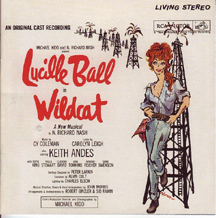
Raymond J. Steiner, Editor • Cornelia Seckel, Publisher
(845) 246-6944 ·
info@ArtTimesJournal.com
 |
Super Star = Super Troubles
By
FRANK BEHRENS
ART TIMES March 2009
There are many
cautionary tales out there about reasons for the failure of seemingly
promising Broadway musicals. One
of the reasons is the ill-advised decision to take a Super Star and
build a show around that luminary. As the recent history of the American
musical theatre can abundantly demonstrate in three words: It don’t
work!
Take
this case in which a Super Star was contracted to play a secondary character.
One
of Eugene O’Neill’s lighter plays is “Ah, Wilderness” (1933); and some
decades later, David Merrick thought it might be ripe for musicalization.
Once the idea gelled, Walter Pidgeon and Eileen Hurlie were cast (both
excellent actors but really non-singers) along with the immensely popular
Jackie Gleason in the role of Uncle Sid. This character was a sort of
comedy relief role, but Gleason was the Great One, as he liked to be
called, and secondary roles were too small for him.
Gleason also insisted that he get $50 more than
the then highest paid actor on Broadway and wound up with $5050 a week!
As his role took on more importance, the balance of the show went all
out of kilter; but he did draw audiences. However, when the audiences
dwindled, the Great One got bored and began to deviate from the script
and from the dance routines. When he pulled a ligament on stage, he
left the show, but Merrick hired a detective to be sure Gleason really
was incapacitated. His replacement was the less flamboyant but more
dependable William Bendix.1
When
the show closed, it closed with a deficit, while Gleason got a Tony
Award for Best Actor in a musical. (Considering what he did to the show,
I think this was a shame.) One should always be aware of the Super Star
comedian. But that lesson has to be learned over and over again.
Another
comedian known to be uncontrollable but still cast to bring in audiences
was Jerry Lewis. Now the old Olsen and Johnson “Hellzapoppin” is not
exactly an intellectual evening in the theater and it can bear a star
whose unpredictability might be an asset. However, Lewis decided he
could dictate what should be done about the show that had little to
do with his role. For example, there was his insistence that a young
female protégé of his be cast in place of more seasoned performers.
Although
we must never second-guess what motivated a person to do this and that,
his connection with the female concerned might have caused the more-than-just-friction
between Lewis and his co-star, the excellent Lynn Redgrave. Rumor had
it that Redgrave’s fine performance was putting the younger woman into
the background—which was almost certainly true.
It
is also true that incompetence was shown by others on other levels.
But the fact remains that the show’s Broadway opening was cancelled
and that was that.2
Even
worse is the story of Rodgers and Hart’s “I’d Rather be Right.” Egos
did not come larger than that of George M. Cohan, who was coaxed into
playing President Franklin Delano Roosevelt. For starters, he detested
Roosevelt. Worse yet, he was used to starring only in shows with music
and lyrics by…George M. Cohan! From early on, he made it clear to Richard
Rodgers that not one song was good enough. Rodgers, always hypersensitive
to criticism, felt his music was running a poor third to lyrics and
book, and lacked inspiration to produce anything really good for the
show.
The
show ran 290 performances and would be only of historical interest if
revived today. Cohan, of course, is still Mr. Broadway in the annals
of the American Musical.3
There
is one more danger that must be mentioned in the context of the troubles
of building a show around a Super Star. When the immensely popular Lucille
Ball was given the lead in “Wildcat,” the critics pointed out that she
was the only positive factor in a less than mediocre musical. The show
ran only 171 performances, but there were many nights in which Lucy
was simply too exhausted to appear—and who wanted to see a rotten
show without the star, who was the only reason for having purchased
the tickets in the first place?
Rule:
When the situation dictates that the STAR must go on, the SHOW has little
hope.
Sources
(1)
The program notes for the RCA Victor CD of “Take Me Along.”
(2)
Second Act Trouble by Steven Suskin (Applause Theatre
& Cinema Books, 2006)
(3)
Somewhere for Me: a Biography of Richard Rodgers by Meryle Secrest
(Knapp, 2001)